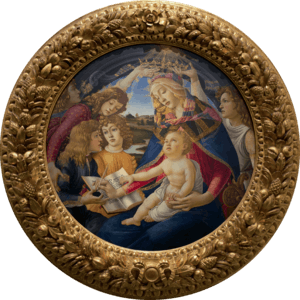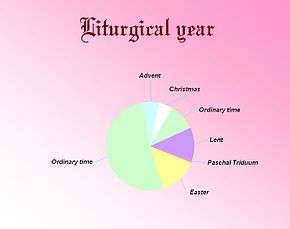Feast of the Annunciation

The Feast of the Annunciation, contemporarily the Solemnity of the Annunciation, commemorates the visit of the archangel Gabriel to the Virgin Mary, during which he informed her that she would be the mother of Jesus Christ, the Son of God. It is celebrated on 25 March each year.[1]
It is a principal Marian feast, classified as a solemnity in the Catholic Church.[2] Two examples in Catholicism of the importance attached to the Annunciation are the Angelus prayer, and the event's position as the first Joyful Mystery of the Rosary.[3]
Biblical narrative
Here is recorded the "angelic salutation" of Gabriel to Mary, 'Hail, full of grace, the LORD is with thee" (Ave, gratia plena, Dominus tecum; Luke 1: 28), and Mary's response to God's will, "Let it be done to me according to thy word" (fiat mihi secundum verbum tuum; v. 38). The "angelic salutation" is the origin of the Hail Mary prayer and the Angelus; the second part of the prayer comes from the salutation of Saint Elizabeth to Mary at the Visitation.[4]
History
The Feast of the Annunciation was celebrated as early as the fourth or fifth century.[5]The first certain mentions of the feast are in a canon, of the Council of Toledo in 656, where it was described as celebrated throughout the Church, and in another of the Council of Constantinople "in Trullo" in 692, which forbade the celebration of any festivals during Lent, excepting the Lord's Day (Sunday) and the Feast of the Annunciation. A Synod of Worcester, England in 1240 forbade all servile work on the feast. As this feast celebrates the Incarnation of the Second Person of the Trinity, many Church Fathers, including St. Athanasius, St. Gregory of Nyssa, and St. Augustine, have expounded on it.[3]
In the Catholic Church, Anglican, and Lutheran liturgical calendars, the feast is moved if necessary to prevent it from falling during Holy Week or Easter Week or on a Sunday. To avoid a Sunday before Holy Week, the next day (26 March) would be observed instead. In years such as 2016 when 25 March falls within Holy Week or Easter Week, the Annunciation is moved to the Monday after the Octave of Easter, i.e., the Monday after the Second Sunday of Easter. [6]
The Eastern churches, (Eastern Orthodox, Oriental, and Eastern Catholic) do not move the feast of the Annunciation under any circumstance. They have special combined liturgies for those years when the Annunciation coincides with another feast. In these churches, even on Good Friday a Divine Liturgy is celebrated when it coincides with the Annunciation. One of the most frequent accusations brought against New Calendarism is the fact that in the New Calendar churches (which celebrate the Annunciation according to the New Calendar, but Easter according to the Old Calendar), these special Liturgies can never be celebrated any more, since the Annunciation is always long before Holy Week on the New Calendar. The Old Calendarists believe that this impoverishes the liturgical and spiritual life of the Church.
The date is close to the vernal equinox, as Christmas is to the winter solstice; because of this the Annunciation and Christmas were two of the four "quarter days" in medieval and early modern England, which marked the divisions of the fiscal year (the other two were Midsummer Day, or the Nativity of St. John the Baptist, on 24 June, and Michaelmas, the feast day of St. Michael, on 29 September).
When the calendar system of Anno Domini was first introduced by Dionysius Exiguus in AD 525, he assigned the beginning of the new year to 25 March, because according to Catholic doctrine, the age of grace began with the Incarnation of Christ at the Annunciation, on which date Jesus Christ is believed to have been conceived in the Virgin Mary by the Holy Spirit.
The Knights of Columbus observe the Feast of the Annunciation as the "International Day of the Unborn Child".[7]
See also
References
| Wikisource has the text of the 1913 Catholic Encyclopedia article The Feast of the Annunciation. |
- ↑ "The Feast of the Annunciation", BBC -Religions
- ↑ Feast of the Annunciation at EWTN
- 1 2 CNA, Solemity of the Annunciation of the Lord'
- ↑ Holy Family Sisters, Annunciation of the Lord
- ↑ Foley O.F.M., Leonard. "Solemnity of the Annunciation of the Lord", Saint of the Day, Lives, Lessons, and Feast, (revised by Pat McCloskey O.F.M.), Franciscan Media
- ↑ Holweck, Frederick. "The Feast of the Annunciation." The Catholic Encyclopedia. Vol. 1. New York: Robert Appleton Company, 1907. 19 Aug. 2014
- ↑ "Feast of the Annunciation", Illinois Knights

